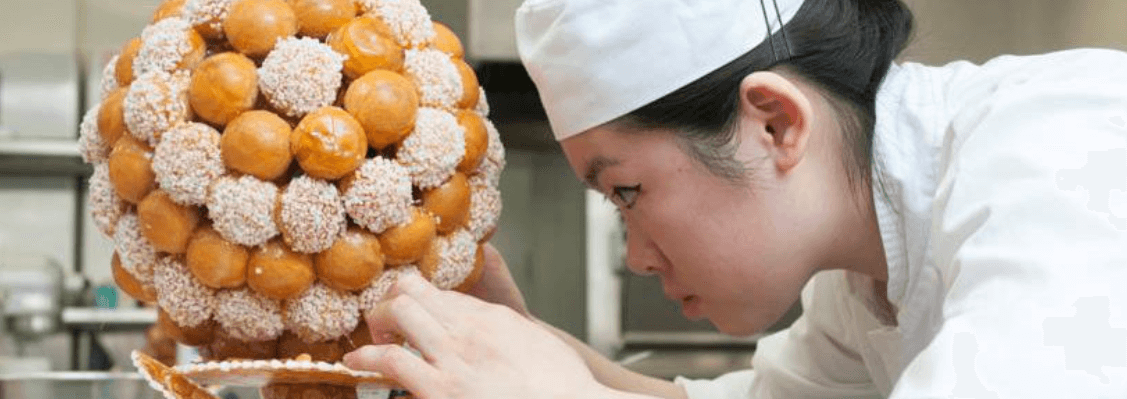IWD 2017 : Interview with Polly Chan
Polly Chan, pastry chef at Pennyhill Park Hotel, knows what it means to be bold. At only 24 years old, she’s rising to the top of a male-dominated industry. Polly was recently named Young Pastry Chef of the Year at the prestigious Royal Academy of Culinary Arts Annual Awards of Excellence 2016 after the judges were blown away by her spherical croquembouche showpiece.
As part of her prize, she attended the Maple Festival in Montreal last month, as a guest of the Federation of Quebec Maple Syrup Producers. Following her return from the trip, we caught up with Polly to find out what she loves about her industry, what advice she has for aspiring pastry chefs, and what she thinks gives her that bold edge in such a competitive industry.
Why did you become a pastry chef?
Originally, I wanted to become a graphic designer creating things that revolved around the five sensory elements (touch, taste, sight, smell and hearing), but during that path, I realised that there is no sensory experience more engaging than eating. Growing up in a food hospitality background with my parents having a takeaway and my Dad as head chef, I’ve always been innately interested in food; I always find myself particularly attracted to the sweeter side. I enjoy working in the main kitchen, but a pastry kitchen brings me the most joy.
What do you love the most about your job?
I love that you can create extraordinary products from basic ingredients and the idea that if you can think it, you can make it. Every day, when I see the final outcomes of products, I think to myself ‘Wow, that was created from normal ingredients – nothing particularly special or unavailable in any supermarket’. Not only this, but the learning process is incredible: knowledge from around the world, practising techniques and seeing your imagination come to life are all great parts of becoming a better pastry chef.
Why did you enter the RACA Young Pastry Chef of the Year Award?
Having changed my career choice not too long ago, I actually just wanted to see how far I could go and did not expect to win it at all! Entering the Awards of Excellence would allow me to challenge myself in my own way and observe the other competitors styles and skill sets – a really great experience to befriend junior and senior chefs from various institutions.
What was the process to enter the Awards of Excellence?
My story is a funny one. Initially, I was not supposed to enter at all because my previous work (Yauatcha) could only put forward two participants. However, during this time the Junior World Chocolate Masters was also taking place, so one of the original participants retracted their entry and so a glistening opportunity was staring right in front of me. I pounced at the chance. There are three stages: written, semi-final and final stage. For the written, you explain reasons why you want to enter, what you would do if you won and explain how the competition improve your future. In the semi-finals, it is a practical test of basic pastry knowledge and skill; as for the finals, it is to showcase style and creativity along with more advanced products.
What do you think gave you the edge to win?
To be truthfully honest, I am not sure. All the participants created amazing croquembouche show pieces, soufflés and linzer tortes. Perhaps, it was because my sphere croquembouche was so unexpected and out of the ordinary, it shocked the judges a little. Believe it or not, my inspiration to create a round croquembouche stemmed from the curiosity to question ‘Why can’t it be round?’… Also, my favourite shape is a circle. It was undoubtedly risky, but I really wanted to prove to myself and chefs everywhere that creating something so different from the original can look just as good.
What would be your advice to young people looking to enter the industry?
Be happy, work hard, always be proud of yourself and never stop learning. This is ultimately the only rule I follow in work and life. When you are happy, you work better, think faster and open your mind to absorb more information. Of course, kitchen life is always tough, hours are long and wages very little, but this is why you need to work harder – every experience is a challenge and test for you in becoming a stronger character. Chef life is like a video game: you reach checkpoints, you achieve skills along the way and you are always running around.
How do you think the industry needs to change to attract more women?
Though many kitchens are often very male-dominated, personally I have never experienced it. However, I have heard stories from my friends and colleagues. The balance in kitchens has very much improved as both genders provide positive elements to a united kitchen. I think becoming a chef is a very personal decision that requires much more mental strength than it may appear. Personally, the industry does not need to attract more females or males. Instead it needs to attract more determined, hardworking individuals with the passion to strive and become great.

A natural source of energy
Maple syrup is a natural source of energy. Check out our recipes for food and drinks before, during, and after exercise.
)